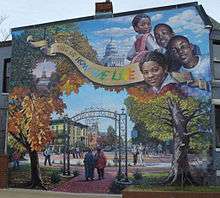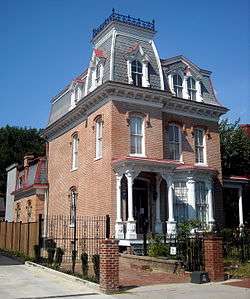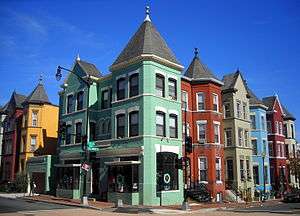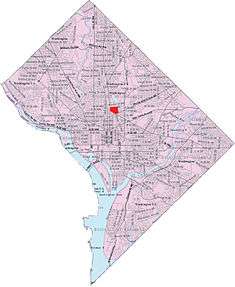LeDroit Park
|
LeDroit Park Historic District | |
|
Intersection of 4th & T Streets, NW in LeDroit Park | |
|
Map of Washington, D.C., with Le Droit Park highlighted in red | |
| Location | Bounded roughly by Florida, Georgia, and Rhode Island Avenues, 2nd and Elm Streets, NW, Howard University, Washington, D.C. |
|---|---|
| Coordinates | 38°55′8.5872″N 77°1′1.326″W / 38.919052000°N 77.01703500°WCoordinates: 38°55′8.5872″N 77°1′1.326″W / 38.919052000°N 77.01703500°W |
| Built | 1873 |
| NRHP Reference # | 74002165 |
| Added to NRHP | February 25, 1974 |
LeDroit Park (/ləˈdrɔɪt/ or /ˈliːdrɔɪt/)[1] is a neighborhood in Washington, D.C. located immediately southeast of Howard University. Its borders include W Street to the north, Rhode Island Avenue and Florida Avenue to the south, Second Street NW to the east, and Howard University to the west.[2] LeDroit Park is known for its history and 19th century protected architecture. The community's diversity entices new residents to the community, as well as its close proximity to the Shaw–Howard University Metro station [3] and many dining options.[4]

History
The neighborhood was founded in 1873 by Amzi Barber, a businessman who served on the board of trustees of neighboring Howard University. Barber named the neighborhood after his father-in-law, LeDroict Langdon, but dropped the ⟨c⟩.[5]
As one of the first suburbs of Washington, LeDroit Park was developed and marketed as a "romantic" neighborhood with narrow tree-lined streets that bore the same names as the trees that shaded them, differing from the street names used in the rest of the city. Extensive focus was placed on the landscaping of this neighborhood, as developers spent a large sum of money to plant flower beds and trees to attract high-profile professionals from the city. Originally a whites-only neighborhood, LeDroit Park was even gated with guards to promote security for its residents. Efforts by many, especially multiple actions by students from Howard University, led to the integration of the area. In July 1888 students tore down the fences that separated the neighborhood in protest of its discriminating policies.
By the 1940s LeDroit Park became a major focal point for the African-American elite as many prominent figures resided there. Griffith Stadium, the home of the Washington Redskins and Washington Senators was also located here until 1965, when the Howard University Hospital was built where it used to stand. Le Droit Park includes Anna J. Cooper Circle, named for the education pioneer.
Historic District
Today, the neighborhood's historic value is officially recognized as the LeDroit Park Historic District.[6][7] The historic district includes the Mary Church Terrell House, a U.S. National Historic Landmark. The neighborhood was awarded a place on the National Register of Historic Places in 1974.[8]
Heritage Trail
On October 17, 2015 the LeDroit Park Heritage Trail was opened.[9] Featuring 16 signs, the 90-minute walking tour chronicles the history of the neighbborhood and its residents.[10] The Trail begins where Florida Avenue, 6th and T Streets, NW meet at the “gateway” to LeDroit Park.[10]
Architecture
One of LeDroit's most recognizable features is its Victorian mansions, houses and row-houses, designed by architect James McGill. None of the original 64 homes McGill designed in LeDroit Park were identical [3] and most were built between 1873 and 1877.[4] Today, 50 of the original homes remain.[11] McGill was also a member of the LeDroit Park Property Owners Association, a precursor to the LeDroit Park Civic Association, which is active today.[12] LeDroit's protected housing stock includes 12 different styles of homes.[13]
Public spaces and art
When the Gage-Eckington School Elementary School closed, residents successfully lobbied the city to tear it down and convert it into a park, which opened in 2011 as The Park at LeDroit.[4] The park houses a large playground, a dog park and the Common Good City Farm, an urban agriculture education center and community garden with 40 plots. In May 2011, His Royal Highness Prince Charles of Wales visited the Common Good City Farm.[3][14]

Murals are painted on many walls throughout the neighborhood. In the Park at LeDroit, "This is How We Live" was commissioned by the DC Commission on the Arts & Humanities to be painted by artist Garin Baker.[15][16] The mural shows the African-American heritage of the neighborhood, the changing community and landscape and historical and architectural scenes from the past and present. At the dedication on December 13, 2008, Mayor Adrian M. Fenty is quoted as describing the mural as serving to
...visually engage residents through a beautiful neighborhood mural that depicts the unique landscapes, people and images of the historic LeDroit Park community. The mural will become a prominent landmark in the neighborhood for years to come.[17]
Notable residents
 | |
|
| |
|
|
- General William Birney – Civil War Veteran owned the stately mansion on Anna J. Cooper Circle. (T & Second Street)
- Senator Edward Brooke – First African-American to win the senate seat by popular vote, was born in this house in 1919. (1938 Third Street)
- Dr. Ralph J. Bunche – The first African-American to receive the Nobel Peace prize, for his mediation in Palestine; resided in LeDroit Park during his professorship at Howard University. — (No address found)
- General Benjamin O. Davis Sr. – The first African-American general. Father of Ben O. Davis Jr; commander of the World War II Tuskegee airmen. (No address found)
- Hon. Oscar De Priest – First Black Congressmen after reconstruction, lived here for his three terms in office. (419 U Street)
- Paul Laurence Dunbar – Black poet laureate & Howard University alumnus. (321 U Street)
- Duke Ellington – jazz legend, lived in the neighborhood with his family during his early childhood. (420 Elm Street)
- Major Christian Fleetwood – One of the first Blacks to be awarded the Medal of Honor. (319 U Street)
- Julia West Hamilton – Civic leader and member of N.A.C.W. (320 U Street)
- Rev. Jesse Jackson – Civil rights activist and founder of the Rainbow/PUSH Coalition. (Corner of Fourth & T Streets)
- Ernest Everett Just – Professor in biology, researcher in biogenetics with significant contributions to zoology and biogenetics. (412 T Street)[20]
- Dr. Jesse Lawson and Dr. Anna J. Cooper – Both prominent educators who founded Frelinghuysen University to educate Blacks working-class adults. Lawson also was a Lawyer (Howard University Law, 1881) who advocated for the rights of poor D.C. residents. (201 T Street)
- Willis Richards – Prominent playwright credited with having the first serious play to be performed on Broadway. (512 U Street)
- Mary Church Terrell – Heiress and activist for civil rights and woman’s suffrage. (326 T Street, National Historic Landmark)
- Walter Washington – the first mayor of DC elected under home rule (408 T Street)
- Clarence Cameron White – A Prominent Violinist educator in fine arts and Howard Alumni (No address found)
- Dr. Garnet C. Wilkinson – Superintendent of Colored Schools during segregation. (406 U Street)
- Octavius Augustus Williams – U.S. Capitol Barber and first Black to move into LeDroit Park in 1893 (338 U Street)
References
- ↑ Left for LeDroit – How do you pronounce ‘LeDroit’?
- ↑ National Park Service, http://www.nps.gov/nr/travel/wash/dc65.htm
- 1 2 3 Reinink, Amy (2011-07-15). "Where We Live: Legacy and location in LeDroit Park". The Washington Post. p. 2. Retrieved 2012-03-16.
- 1 2 3 Unger, Mike (2011). "LeDroit Park brings neighbors together". Washington Examiner. Retrieved March 7, 2012.
- ↑ Williams, Paul Kelsey (November 2007). "100 years Ago Major Business Mogul Lived High". Intowner. Retrieved March 7, 2012.
- ↑ Note: A National Register of Historic Places Inventory-Nomination document should be available upon request from the National Park Service for this site, but it appears not to be available on-line from the NPS Focus search site.
- ↑ "LeDroit Park Historic District". Washington D.C. National Register of Historic Places Travel Itinerary listing. National Park Service. Retrieved 2008-05-12.
- ↑ National Park Service (2007-01-23). "National Register Information System". National Register of Historic Places. National Park Service.
- ↑ "Long Awaited LeDroit Park/Bloomingdale Heritage Trail Now Open". Retrieved 23 October 2015.
- 1 2 Bennett, Maybelle (9 October 2015). "Long Awaited LeDroit Park/Bloomingdale Heritage Trail Now Open". InTowner. Retrieved 23 October 2015.
- ↑ "LeDroit Park: a D.C. oasis". GWU Hatchet. GWU Hatchet. Retrieved 2012-03-12.
- ↑ "Civic Associations Past". LeftforLeDroit.com. Left for LeDroit. Retrieved 2012-03-12.
- ↑ LeftforLeDroit.com. Left for LeDroit http://leftforledroit.com/2012/06/ledroit-park-architectural-guide-now-online/. Retrieved 2015-03-12. Missing or empty
|title=(help) - ↑ Beerman, Judith (2011). "Prince Charles Visits Common Good City Farm in LeDroit Park". Georgetown Dish. Retrieved March 7, 2012.
- ↑ http://incorrigiblecurmudgeon.blogspot.com/2009/07/i-lovethis-mural.html
- ↑ http://staging.carriageart.com/?p=313
- ↑ Mas Tadesse (2008). "LeDroit Park Mural Dedication". DCAAH News Releases. DC Commission on the Arts & Humanities. Retrieved 18 December 2010.
- ↑ "WETA Neighborhoods, Ledroit Park". WETA-TV. December 31, 2005. Retrieved February 28, 2013.
- ↑ "http://www.nbm.org/media/video/house-home/ledroit-park-house-and-home.html". National Building Museum. October 11, 2012. Retrieved February 28, 2013. External link in
|title=(help) - ↑ "World War I Draft Registration Card [database on-line]". United States: The Generations Network. 1918-09-12. Retrieved 2010-10-22.
External links
| Wikimedia Commons has media related to LeDroit Park. |
- LeDroit Park Civic Association
- Left for LeDroit, neighborhood blog
- Left for LeDroit LeDroit Park Heritage Trail
- Rare 1880 Plan of LeDroit Park
- Why Is It Named LeDroit Park?
- 1907 Map of LeDroit Park and Bloomingdale
 |
Pleasant Plains | McMillan Reservoir |  | |
| U Street Corridor | |
Bloomingdale | ||
| ||||
| | ||||
| Shaw | |
Truxton Circle |

